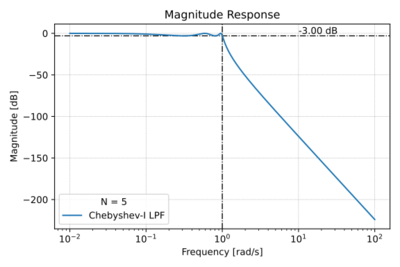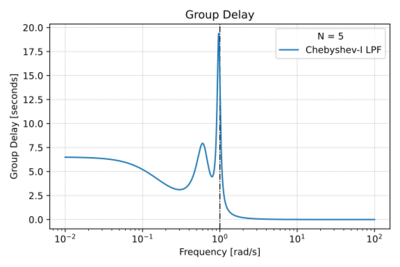Difference between revisions of "Chebyshev Filters"
| Line 18: | Line 18: | ||
</math>|{{EquationRef|1}}}} | </math>|{{EquationRef|1}}}} | ||
| − | Where <math>\omega_0</math> is the cut-off frequency, <math>\varepsilon=\sqrt{10^\frac{\delta}{10}-1}</math> is the ripple factor with ripple <math>\delta</math> in dB, and <math>T_N\left(x\right)</math> are solutions to the Chebyshev differential equation: | + | Where <math>N</math> is the filter order, <math>\omega_0</math> is the cut-off frequency, <math>\varepsilon=\sqrt{10^\frac{\delta}{10}-1}</math> is the ripple factor with ripple <math>\delta</math> in dB, and <math>T_N\left(x\right)</math> are solutions to the Chebyshev differential equation: |
{{NumBlk|::|<math> | {{NumBlk|::|<math> | ||
Revision as of 01:28, 16 March 2021
Chebyshev filters come in two flavors: the Type-I and Type-II.
The Chebyshev Type-I Low-Pass Filter
Chebyshev Type-I filters are also all-pole filters, with poles of the normalized () filter located on an ellipse inside the unit circle, as shown in Fig. 1. This arrangement of poles results in (1) a shorter transition band, and therefore a steeper roll-off compared to the Butterworth low-pass filter of the same order, shown in Fig. 2, (2) poorer group delay characteristics as depicted in Figs. 3 and 4, and (3) ripples in the pass-band also seen in Fig. 2. By allowing larger ripples in the pass-band, we get: (1) a narrower transition band, and hence sharper cut-off, (2) higher Q poles, and (3) more degradation in the phase response.
The Chebyshev Type-I magnitude response is given by:
-
(1)
-
Where is the filter order, is the cut-off frequency, is the ripple factor with ripple in dB, and are solutions to the Chebyshev differential equation:
-
(2)
-
For a normalized filter, or , the poles of the Chebyshev Type-I low-pass filter are the roots of . In practice, instead of solving this equation directly, we can easily get the roots (and hence the poles) of the filter transfer function using tools such as Python or Matlab.














